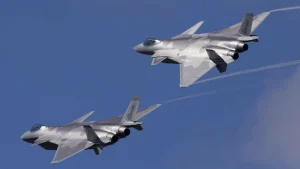US Threatens to Shut Down TSMC’s EUV if China Reunifies with Taiwan by Force
Those in Washington are truly worrying about the situation in Taiwan these days. However, among the few things they can actually do, apart from promoting arms sales that enrich themselves and the military-industrial complex, is issuing warnings or threats. But sometimes it’s hard to know who’s the one got threatened.
According to the latest report from Bloomberg, in the event of China’s reunification with Taiwan by force, the US can remotely disable all Chinese weapons! What a genius strategy!
The only problem is that’s not possible. So instead, with the urge of doing something (no matter what) in the event of Chinese military action, they choose to disable the EUVs for manufacturing advance microchips the world depends on.
Still a brilliant strategy, isn’t it? Imagine how big trouble it would cause to the Chinese semiconductor industry, which is already heavily sanctioned. It’s only natural to top it all with a push of the blue button (or a red button? If such a thing ever exists), and then all the EUVs in China suddenly become useless.
On the receiving end, China certainly should take this warning seriously, and start to inventory all the EUVs currently in its possession to estimate the potential loss. Good news, there’s no EUV ever been shipped to Chinese mainland. Bad news: the only place in the country where you can find these most coveted machines nowadays is in Taiwan.
Therefore, in the hypothetical scenarios, the US will pressure ASML, the manufacturer, to shut down EUV remotely from the Netherlands. Although in such circumstance, the US are more likely to order the machines to be destroyed. Why bother pressuring others to shut it down when you can just bomb it, especially considering that the US already has special forces and secret agents on the ground in Taiwan? After all, bombing is what a superpower does.
That is to say, in such a bizarre scenario, both China and the US would be bombing this small island. See? There is common ground between the two.
Another reason I would recommend destroying the machine, rather than just disabling it, is the crucial parts of EUV can be reused even after being shut down.
As we know, the most crucial part of an EUV machine for microchip production is the optical system, specifically the projection optics and illumination system. These components play a vital role in directing and focusing the extreme ultraviolet (EUV) light onto the silicon wafer, allowing for the creation of intricate patterns that define the functionality of each microchip. The optical system, including mirrors that reflect and direct light with nanometer precision, is essential for achieving the high level of detail and precision required in lithography processes. Keeping the optical system intact will render the whole remotely disabling technique pointless.
Trying to deter or dissuade China from taking back Taiwan by threatening with EUV machines sounds ridiculous. For the US, it’s more of a damage control to deny China the extra benefits of reunification than a real strategy.
But what if China doesn’t need these EUVs by then? In fact, Chinese companies are taking a very different approach than their Western counterpart in building lithography machines. According to reports, Huawei and China’s Semiconductor Manufacturing International Co. (SMIC) have submitted patents for a chip production method called self-aligned quadruple patterning (SAQP).
The SAQP process enables the creation of microchip patterns that have dimensions smaller than what can be achieved using traditional photolithography techniques alone. It accomplishes this through a multilayer patterning approach that mimics the meticulous construction of an extremely detailed scale model. Specifically, it first deposits an initial layout of wider features and leaves spacing in between to guide subsequent steps. Rail-like structures are then formed on the sides of these features to designate where narrower patterns will be placed. The initial features are removed, leaving only the rail structures behind, upon which a thin layer of material is deposited to start forming mini-scaled features between the rails. Excess material is cleaned away to reduce these dimensions even further. The process repeats, adding more rail structures and then selectively etching material, to carve out increasingly finer lines and spaces that can be as narrow as one-third the width of a human hair. This allows integrated circuit manufacturers to print vastly smaller circuitry elements than standard photolithography, which is technically capable of achieving this in a single photochemical exposure. Using SAQP, HUAWEI and SMIC will produce 5nm-class process microchips, which will meet most of the demand.
With that being said, the more important message here for the US policymakers is to never look at the Taiwan issue through the lens of semiconductor production, as compared with China’s reunification, they are issues of two different levels of magnitude.
Chinese communications expert Xiang Ligang believes remotely disabling lithography machines is technically feasible, but there are countermeasures against remote sabotage that could allow operations to restart. However, the shockwaves would still be catastrophic for companies and device makers dependent on the chips.
“TSMC is a civilian company, but the advanced chips it produces supply major U.S. tech giants like Qualcomm, Apple, Nvidia, AMD – a huge chunk of the American semiconductor industry.
If TSMC’s lithography machines were neutralized, there are two monumental issues. One, under what laws could ASML cripple a customer’s machines? That would decimate their commercial credibility. Who would ever import their equipment again? Their temporary edge would quickly erode as rivals caught up. It’s a self-destructive path.”
“If TSMC’s operations were paralyzed, wouldn’t that obliterate scores of U.S. companies? Wouldn’t the entire American chip industry simply collapse?”



